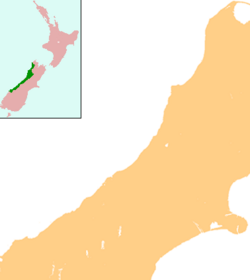Ruatapu, New Zealand facts for kids
Quick facts for kids
Ruatapu
|
|
|---|---|

Ruatapu, with Lake Mahinapua shown in the foreground, and the Tasman Sea in the background.
|
|
| Country | New Zealand |
| Region | West Coast |
| District | Westland District |
| Electorates | West Coast-Tasman Te Tai Tonga |
| Time zone | UTC+12 (NZST) |
| • Summer (DST) | UTC+13 (NZDT) |
| Postcode |
7883
|
| Area code(s) | 03 |
| Local iwi | Ngāi Tahu |
Ruatapu is a small town in the Westland District on the West Coast of New Zealand's South Island. Its name comes from Ruatapu, a famous person in Māori mythology. The town sits on a narrow strip of land. On one side is the Tasman Sea, and on the other is Lake Mahinapua. This lake used to be a coastal lagoon, which is a shallow body of water separated from the sea.
State Highway 6 runs right through Ruatapu. This road connects the town to nearby places like Hokitika and Ross. Ruatapu's economy mainly relies on agriculture, like farming. It also has a big sawmill run by Westco Lagan. This sawmill cuts down Radiata Pine trees. The wood is then sent to Christchurch for more processing.
Ruatapu's Past
Ruatapu has an interesting history, especially when it comes to transport and industry.
The Railway Story
On November 9, 1906, a new part of the Midland railway line opened. This line ran from Greymouth to Hokitika. The new section was a branch line that went all the way to Ruatapu. For a while, Ruatapu was the very end of the railway line.
Then, on April 1, 1909, the line was extended further to Ross. After this, it became known as the Ross Branch. Trains carrying passengers stopped running on October 9, 1972. The entire line closed for all types of traffic on November 24, 1980. Today, you can even drive on some parts of the old railway path near Ruatapu.
The Sawmill's Journey
In 1907, a man named Joseph Butler bought a huge area of forest. It was about 28,000 acres of rimu, matai, and kahikatea trees. He paid £28,000 for this land, which was a lot of money back then. Joseph and his brother William started a company called Butler Brothers Ltd. A big company called Kauri Timber Co was a major investor.
A large sawmill, powered by steam, started working in 1911. But nature can be powerful! In October 1915, a big storm hit. It ripped the roof off the sawmill. It also destroyed a small hut and even moved a house from its foundations. The original mill burned down in 1952. A new electric-powered mill was built in 1955. Sadly, it burned down again in the early 1980s, but it was rebuilt once more.
Over the years, the sawmill changed owners several times. Fletcher Holdings took over the mill in 1961. Then, in 1979, they sold it to Henderson & Pollard Ltd. This company later became part of Carter Holt Harvey in 1987. Finally, in 1988, the mill was sold to Westco Lagan Ltd, which still operates it today.
For a long time, special tramways were used to move logs. These small railways ran up to 20 kilometers south from the mill. But by 1960, they were replaced by large logging trucks, which could carry logs more easily.


